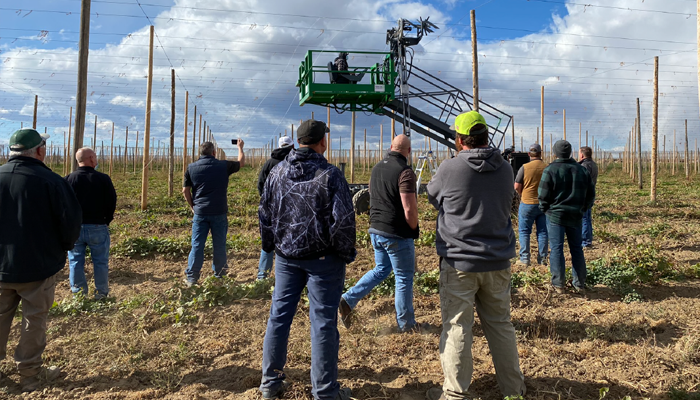Over six years ago, the concept of a pay by weight, in-field harvest scale sparked the foundation of 2nd Sight. Six years later, our flagship product, the "FairPick Pro" is a simple, reliable system that offers growers the benefits of fair and accurate pay. Along the way, we developed additional labor tracking systems that would satisfy the needs of our current and future customers to have one complete labor tracking solution.
The 2nd Sight engineering team began development of the second generation FairPick model only a year after the commercial release of our original FairPick system. We decided to call the original model the “FairPick Pro” because it was a pro at being a rugged, user-friendly harvest scale. The name made sense.... at the time.
The inspiration behind the new FairPick model was to develop a tabletop scale system. Instead of an integrated computer, it would utilize a handheld computer that could be removed and run other 2nd Sight labor tracking apps outside of the often-short harvest window. For growers, the cost of the system could then be spread over several months of use instead of just a couple. The name “FairPick Lite” stuck because of its portability, not thinking it would be attached to the mobile, metal frame like the “Pro” as well as the portability of the handheld that could be removed from the box.
The “brain” of the FairPick Lite system is in the rugged handheld computer that runs the app. Because of this, our engineers can more easily modify and add features to the software which has transformed the FairPick Lite into a feature-rich app. Before implementation, we work with a grower to determine whether a “Pro” or “Lite” system would be a better fit for the farm. During these conversations, I often find myself explaining that there is always a tradeoff between simplicity and flexibility. If you want something that is extremely user-friendly, you will have to sacrifice some features and data flexibility. However, if you are not afraid of working a smart phone out in the field, you can have more options to customize the software to your process.
We have also always referred to the electronics box of the FairPick Lite system as the “FlexHub”. This was a name that reflected another new gadget on the market at the time of development, the Nintendo "Switch". This console was designed to offer both stationary and portable options for gamers as well as standard hardware to make game development easier for programmers. Sound familiar?
Although the “Pro” is an excellent solution for a farm that seeks simplicity, the “Lite” is a better fit for a farm that wants to maximize the hardware and software possibilities. The names have become counterintuitive and do not best represent each system's strengths. Sometimes, you must admit that a product has outgrown its moniker. Moving forward, the “FairPick Pro” will be referred to as the “FairPick", going back to its roots as the machine that fully-embraces reliability and simplicity. And, to make a long story short, the word flex keeps coming up when we talk about the “FairPick Lite”. So, we would like to introduce to you the same great system rebranded as the "FairPick Flex"!
For most of us, 2020 has been a year of change and adaption, so what better time to embrace a little rebranding!
Software has become an important tool for growers, improving farm efficiency and providing accurate and timely information to make better, more profitable decisions. However, sometimes we forget that we must run software on something. From the inception of our flagship product, the FairPick scale, we realized that the combination of hardware and software would be key for our products to work well on the farm. The device that would run our labor tracking software would need to be rated for outdoor use and designed for industrial applications.
When we started talking to more growers, we learned that the FairPick scale offered a great solution for tracking harvest and produce picked but did not offer an easy way to track other employee time and piecework jobs. The ability to electronically record all work on the farm was the next step. This prompted our search for a manufacturer that offered industrial handheld computers to run our Android applications. Our partnership with Cipherlab has allowed us to deliver several models of handhelds over the last four years that meet our expectations and the needs of our customers.
Cipherlab manufactures mobile devices that offer the latest and greatest technology for many industrial applications. By using Cipherlab handhelds, it ensures that our software is compatible with the operating system of the device. It also allows our software to “talk” to other components on the device (sound, barcode scanner, NFC scanner, etc.). Technology changes so rapidly that it can be challenging for a software provider to guarantee that their applications work on all devices. We know that growers cannot tolerate much downtime with their technology, so pairing hardware with our labor tracking and product tracking software can make our systems more reliable.
Here are some other benefits of using Cipherlab handhelds versus typical cell phones to run 2nd Sight software:
- Built-in barcode scanners with physical scanner button for ease-of-use
- Hot-swappable batteries, spare batteries, and charging docks for extended workdays
- AppLock program that allows an admin to permit only certain apps be opened which prevents misuse and abuse of the device by employees
- Wi-Fi or SIM card capabilities for full data upload flexibility
- Built-in NFC reader that scans RFID cards and tags so that employee badges can be sturdy, get dirty, and get wet (unlike barcode badges)
- Ability to install micro SD cards for additional data back-up If the handheld is damaged
In 2020, we released the RS51 handheld for our FairPick Lite and FairTrak systems. This update to the RS50 includes an improved operating system and more processing power which means that it can handle a lot of data quickly. In 2021, we will release the RS35 handheld for use with our InstaCaliper and TallyTrak system. The RS35 will also boast more processing power and its integrated barcode scanner will now support 2D barcodes.
Ready to learn more about how our hardware and software work together as an integrated solution for your farm, nursery, or greenhouse? Send us an email or give us a call and we would be happy to explain why paying a little more for hardware will pay off when you need it most!
We are always looking to the future. The future holds unknowns in terms of new challenges and new solutions. We hope that the future brings growth for ourselves and our businesses. What does the future look like for specialty crop farming? Where is the industry heading as a whole? Does change always mean improvement?
From day one, the 2nd Sight team wanted to bring technology to an industry that often falls behind the curve in terms of what technology is available and how quickly new tech is accepted and adopted. However, initial enthusiasm is often followed by apathy, skepticism, or rejection altogether. Our story often feels like one of Sisyphus rolling that rock up the hill. Will the adoption of new technology “make or break” a farming operation in the next few years? Or will growers get by with the same methods? Will these “tried and true” systems, tools, and methodologies work despite changing circumstances?
Over the last year and a half, our engineering team has been hard at work developing a vehicle that will have various attachments to automate labor-intensive jobs associated with growing hops. The most important innovation of the MAV (Multifunctional Agriculture Vehicle) is the automated tying mechanism that will attach twine to the top trellis cables. This job has always been done by crews of workers tying hundreds and thousands of knots by hand every spring.
Using automation equipment and new technology to decrease labor expenses is a common theme in Precision Ag conversations. If crop prices remain the same and expenses are increasing, a farm only has one option to increase profitability—decrease expenses. Labor will almost always be a company’s biggest expense.
2nd Sight reached a big milestone this month by performing field trials of the MAV and its ability to consistently tie hundreds of knots to trellis wires in a hops yard with only one vehicle operator. It was a first for the industry to see this in action after previous failed attempts at a machine. During a grower demo in Prosser, we ran the machine down a few poles, and it tied wonderfully. When the machine was turned off and the Q&A began, our CEO/President asked what everybody thought about the system. The most audible comment, “Too good to be true”.
I found an interesting article that was written by Alexander Winton who built and sold the first automobile in the US. This is what he said as he reflected on his work:
When I first contemplated the application of gasoline for vehicles, I had a bicycle plant in Cleveland. Because bikes interested me, my mind naturally turned to something a rider wouldn’t have to push and keep pushing if he was trying to get some place. But the great obstacle to the development of the automobile was the lack of public interest. To advocate replacing the horse, which had served man through centuries, marked one as an imbecile. Things are very different today. But in the ’90s, even though I had a successful bicycle business, and was building my first car in the privacy of the cellar in my home, I began to be pointed out as “the fool who is fiddling with a buggy that will run without being hitched to a horse.” My banker called on me to say: “Winton, I am disappointed in you.”
Change is the only constant and there are a lot of companies out there striving to ease the pain points of the specialty crop industry with new technology. The numbers may pencil out for an acceptable ROI, but it still takes a shift in one’s mindset to adopt a new tool or piece of equipment. This can be hard because of minimal empirical evidence of success. It takes a leap of faith from a few to change the industry. It also takes trust that somebody’s idea is a good one. Or, should we go back to using the horse and plow?



